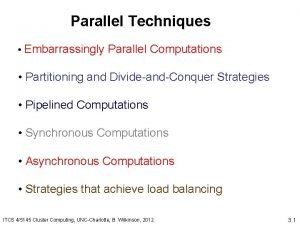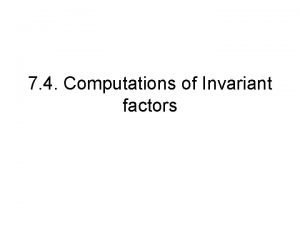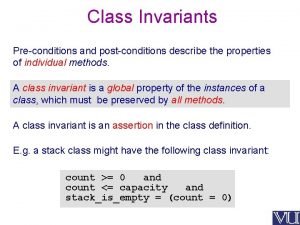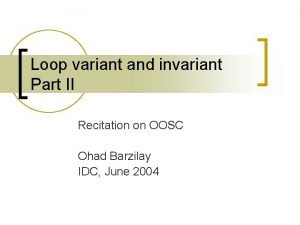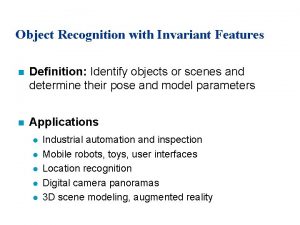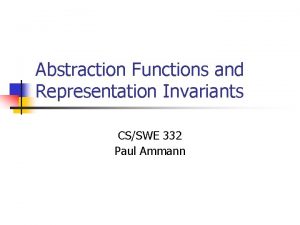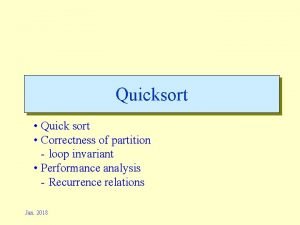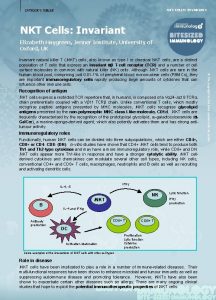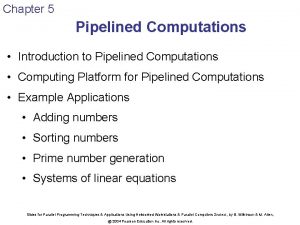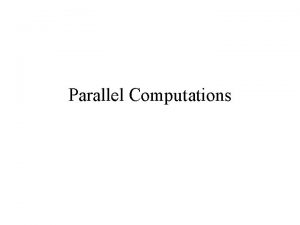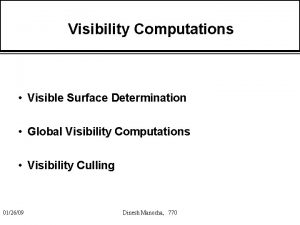7 4 Computations of Invariant factors Let A



![• • Thus det(x. I-A)=p. Elementary row operations in F[x]nxn. 1. Multiplication of • • Thus det(x. I-A)=p. Elementary row operations in F[x]nxn. 1. Multiplication of](https://slidetodoc.com/presentation_image/08c4904880e0388a83a063f3a729bd7c/image-4.jpg)

![• Lemma. M in F[x]mxn. – – – • • A nonzero entry • Lemma. M in F[x]mxn. – – – • • A nonzero entry](https://slidetodoc.com/presentation_image/08c4904880e0388a83a063f3a729bd7c/image-6.jpg)





![• Theorem 9. M in F[x]mxn. Then M is equivalent to a matrix • Theorem 9. M in F[x]mxn. Then M is equivalent to a matrix](https://slidetodoc.com/presentation_image/08c4904880e0388a83a063f3a729bd7c/image-12.jpg)



![• Corollary. Each matrix M in F[x]mxn is equivalent to precisely one matrix • Corollary. Each matrix M in F[x]mxn is equivalent to precisely one matrix](https://slidetodoc.com/presentation_image/08c4904880e0388a83a063f3a729bd7c/image-16.jpg)
- Slides: 16

7. 4. Computations of Invariant factors

• Let A be nxn matrix with entries in F. • Goal: Find a method to compute the invariant factors p 1, …, pr. • Suppose A is the companion matrix of a monic polynomial p=xn+cn-1 xn-1+…+c 1 x+c 0.

![Thus detx IAp Elementary row operations in Fxnxn 1 Multiplication of • • Thus det(x. I-A)=p. Elementary row operations in F[x]nxn. 1. Multiplication of](https://slidetodoc.com/presentation_image/08c4904880e0388a83a063f3a729bd7c/image-4.jpg)
• • Thus det(x. I-A)=p. Elementary row operations in F[x]nxn. 1. Multiplication of one row of M by a nonzero scalar in F. 2. Replacement of row r by row r plus f times row s. (r s) 3. Interchange of two rows in M.

1. nxn-elementrary matrix is one obtained from Identity marix by a single row operation. • Given an elementary operation e. – e(M)=e(I)M. – M=M 0 ->M 1 ->…. ->Mk=N row equivalences N=PM where P=E 1…Ek. – P is invertibe and P-1=E-1 k…. E-11 where the inverse of an elementary matrix is elementary and in F[x]nxn.
![Lemma M in Fxmxn A nonzero entry • Lemma. M in F[x]mxn. – – – • • A nonzero entry](https://slidetodoc.com/presentation_image/08c4904880e0388a83a063f3a729bd7c/image-6.jpg)
• Lemma. M in F[x]mxn. – – – • • A nonzero entry in its first column. Let p=g. c. d(column 1 entries). Then M is row-equivalent to N with (p, 0, …, 0) as the first column. Proof: omit. Use Euclidean algorithms. Theorem 6. P in F[x]mxm. TFAE 1. 2. 3. 4. P is invertible. det P is a nonzero scalar in F. P is row equivalent to mxm identity matrix. P is a product of elementary matrix.

• • Proof: 1 ->2 done. 2 ->1 also done. We show 1 ->2 ->3 ->4 ->1. 3 ->4, 4 ->1 clear. (2 ->3) Let p 1, . . , pm be the entries of the fist column of P. – Then gcd(p 1, . . , pm )=1 since any common divisor of them also divides det P. (By determinant formula). – Now use the lemma to put 1 on the (1, 1)position and (i, 1)-entries are all zero for i>1.

– Take (m-1)x(m-1)-matrix M(1|1). – Make the (1, 1)-entry of M(1|1) equal to 1 and make (i, 1)-entry be 0 for i > 1. – By induction, we obtain an upper triangular matrix R with diagonal entries equal to 1. – R is equivalent to I by row-operations-clear. • Corollary: M, N in F[x]nxn. N is rowequivalent to M <-> N=PM for invertible P.

• Definition: N is equivalent to M if N can be obtained from M by a series of elementary row-operations or elementary column-operations. • Theorem 7. N=PMQ, P, Q invertibe <-> M, N are equivalent. • Proof: omit.

• Theorem 8. A nxn-matrix with entry in F. p 1, …, pr invariant factors of A. Then matrix x. IA is equivalent to nxn-diagonal matrix with entries p 1, . . , pr, 1, …, 1. • Proof: There is invertible P with entries in F s. t. PAP-1 is in rational form with companion matrices A 1, . . , Ar in block-diagonals. – P(x. I-A)P-1 is a matrix with block diagonals x. IA 1, …, x. I-Ar. – x. I-Ai is equivalent to a diagonal matrix with entries pi, 1, …, 1. – Rearrange to get the desired diagonal matrix.

• • This is not algorithmic. We need better algorithm. We do it by obtaining Smith normal form and showing that it is unique. Definition: N in F[x]mxn. N is in Smith normal form if 1. Every entry off diagonal is 0. 2. Diaonal entries are f 1, …, fl s. t. fk divides fk+1 for k=1, . . , l-1 where l is min{m, n}.
![Theorem 9 M in Fxmxn Then M is equivalent to a matrix • Theorem 9. M in F[x]mxn. Then M is equivalent to a matrix](https://slidetodoc.com/presentation_image/08c4904880e0388a83a063f3a729bd7c/image-12.jpg)
• Theorem 9. M in F[x]mxn. Then M is equivalent to a matrix in normal form. • Proof: If M=0, done. We show that if M is not zero, then M is equivalent to M’ of form: • where f 1 divides every entries of R. • This will prove our theorem.

– Steps: (1) Find the nonzero entry with lowest degree. Move to the first column. – (2) Make the first column of form (p, 0, . . , 0). – (3) The first row is of form (p, a, …, b). – (3’) If p divides a, . . , b, then we can make the first row (p, 0, …, 0) and be done. – (4) Do column operations to make the first row into (g, 0, …, 0) where g is the gcd(p, a, …, b). Now deg g < deg p. – (5) Now go to (1)->(4). deg of M strictly decreases. Thus, the process stops and ends at (3’) at some point.

– If g divide every entry of S, then done. – If not, we find the first column with an entry not divisible by g. Then add that column to the first column. – Do the process all over again. Deg of M strictly decreases. – So finally, the steps stop and we have the desired matrix.

• The uniqueness of the Smith normal form. (To be sure we found the invariant factors. ) • Define k(M) = g. c. d. {det of all kxksubmatrices of M}. • Theorem 10. M, N in F[x]mxn. If M, N are equivalent, then k(M)= k(N). • Proof: elementary row or column operations do not change k.
![Corollary Each matrix M in Fxmxn is equivalent to precisely one matrix • Corollary. Each matrix M in F[x]mxn is equivalent to precisely one matrix](https://slidetodoc.com/presentation_image/08c4904880e0388a83a063f3a729bd7c/image-16.jpg)
• Corollary. Each matrix M in F[x]mxn is equivalent to precisely one matrix N which is in normal form. • The polynomials f 1, …, fk occuring in the normal form are • where 0(M): =1. • Proof: k(N) =f 1 f 2…. fk if N is in normal form and by the invariance.
 Let me let me let me
Let me let me let me Embarrassingly parallel
Embarrassingly parallel Incrementalizing graph algorithms
Incrementalizing graph algorithms Invariant factors of a matrix
Invariant factors of a matrix He who has ears let him hear
He who has ears let him hear Me te le nos les
Me te le nos les What did you say
What did you say Precondition postcondition invariant
Precondition postcondition invariant What is this
What is this Invariant
Invariant What is loop variant
What is loop variant Object recognition from local scale-invariant features
Object recognition from local scale-invariant features Invariant features definition
Invariant features definition Distinctive image features from scale-invariant keypoints.
Distinctive image features from scale-invariant keypoints. Representation invariant java
Representation invariant java Scale invariant feature transform
Scale invariant feature transform Loop invariant of quick sort
Loop invariant of quick sort

